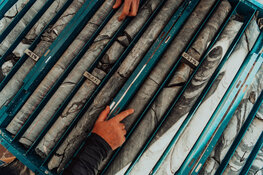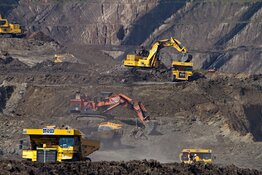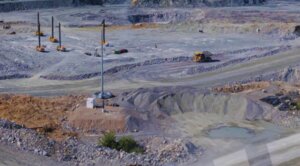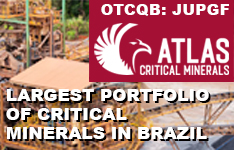The Gold Report: Noel, you're a geologist with about a 40-year history in mineral exploration. These days, public companies pay you for advice on how to run their exploration programs. What are some common mistakes junior mining companies make when it comes to exploration?
Noel White: Junior companies have difficulty developing a clear and realistic strategy.
TGR: You try to temper their enthusiasm?
NW: Not at all. In fact, I try to encourage their enthusiasm. But I try to get what they do aligned with what their objectives are in a realistic way.
TGR: Do they try to drill too quickly? Do they try to drill too much?
NW: Junior companies commonly feel that there is an expectation to drill quickly, but they also need to do their homework properly. If they jump into drilling before doing the appropriate surface techniques, such as geological mapping, geochemical sampling and geophysical surveys, they can completely waste the very expensive drilling work. It is a serious mistake because bad drilling results have a serious negative impact on how investors perceive a project. A company needs the best possible intersections at the start to raise the value of their projects.
TGR: Have you been an active consultant on projects that have reached production and gone on to be successful?
NW: I've worked a long time with Asia Now Resources Corp. (NOW:TSX.V) in China. Asia Now has produced an ore deposit in southern China. That exploration success followed a long period of very careful exploration to find a completely hidden ore body. Without that early work, that success would not have been achieved.
TGR: You often deal with technologies that are new to mineral exploration. Can you talk about how they're changing the game?
NW: The fundamentals of mining haven't changed particularly in 40 years—we just use new technologies to achieve the same goals. The major breakthrough in geophysical technology of recent times was the development of airborne gravity. That was one of the Holy Grails.
One of the most basic tools is a magnetic survey. We can get a lot more out of magnetic surveys today than we could in the past. Those surveys provide us with baseline information that's really important.
Technology is producing major breakthroughs in geochemistry. Geochemistry started off just collecting samples of soil or stream sediments and using simple analytical techniques. More and more sensitive analytical methods have been developed. Partial leach techniques extract part of the geochemical sample to maximize the sensitivity. A major recent development relies on the fact that nature has focused particular elements that are associated with ore deposits into particular minerals. It is now possible to actually look at the chemistry of particular minerals to evaluate the proximity to the target based on its chemistry.
TGR: What do all those technologies mean to the investor?
NW: Smart people follow the lead of smart people and greedy people follow the lead of greedy people. If you follow a greedy person you might get lucky and make a lot of money in the short term. Technically smart people who design exploration programs have a much higher probability of being successful in delivering a discovery.
TGR: A few years ago, the World Bank evaluated the mineral potential of China. How would you characterize China's mineral potential?
NW: To appreciate China's potential, you have to understand its history. In the early days of the People's Republic of China, the country followed the Soviet Union approach and started huge state-funded surveys over massive areas, but the Cultural Revolution disrupted the process. Thousands of state-owned companies with exploration teams suddenly found themselves with no funding. However, the government wouldn't allow them to reduce staff or stop operations—a major dilemma for management. They started mining any little thing to make money.
TGR: The country is literally dotted with all kinds of artisanal mines.
NW: They were so focused on making money that they were acting as if they were the smallest of junior mining companies where making money was the sole focus, not doing good work.
TGR: But the potential is there.
NW: Oh, the potential is staggering. A mineral occurrence map of East Asia shows multiple world-class deposits around the borders of China. However, there are very few inside China. Why did China miss out? It has nothing to do with geology. I has to do with the history of the country and how exploration developed. China is fantastically endowed, but very poorly explored.
TGR: But even the Chinese government is not compelled by its geology. Chinese state-owned companies are spending billions to develop resources beyond its borders. Isn't it difficult to argue for further mineral exploration and development in China when the Chinese themselves seem unconvinced?
NW: A huge amount of money is being channeled by the government into exploration teams in China. Some of them are quite competent, but many of them are not. It's basically pouring good money out after mostly bad.
Then the government asks, "Well, why haven't we found all these deposits in China?" But the "experts" they are asking don't know anything about the economic geology of China. They say, "We've spent a huge amount of money looking for these deposits and haven't found them. Therefore, they mustn't be there." That conclusion is wrong. Most of the money is being used in completely ineffective ways.
TGR: What is the environment for juniors wanting to capitalize on that potential?
NW: The geological potential of China is fantastic. But let's not pretend otherwise—it's a difficult place to work for other reasons. When Asia Now went in 10 years ago, China was encouraging foreign companies to come in. A lot of juniors went into China. Some did quite well. Many of them did really badly. Subsequently, conditions have become less and less favorable. The policies change almost on a yearly basis. It's more challenging today than it was 10 years ago.
TGR: What's the best way to get started in China?
NW: The best way to work in China is to joint venture with a good state-owned company. Asia Now chose very good projects and joint ventured with two partners. It's very much like a joint venture in a Western company. Mining law in China is provincial. Having a Chinese partner that can handle government and community relations for you is a major advantage. Many foreign companies don't understand the system, the requirements—they don't have the connections and the relationships that can make things easier. Life is much easier when you have a good local partner.
TGR: Oyu Tolgoi is the mammoth copper-gold porphyry deposit being developed in Mongolia by Rio Tinto (RIO:NYSE; RIO:ASX). You're an expert in porphyry deposits. Do you believe further exploration of those geological systems could yield a similar deposit in China?
NW: There are a lot of porphyry prospects in China, but there's been very little effective exploration on them. The situation is changing because more Chinese have familiarity with porphyry deposits. However, in most cases, if they even recognize a porphyry, they will drill a couple of holes and walk away because they didn't get what they wanted. Porphyry deposits are very big, but that doesn't mean they're easy to find. They can't just drill a couple of holes and say, "Oh well, we've done it." In fact, Asia Now is exploring a porphyry system that had never been recognized in southeastern China, down toward the Vietnam border.
TGR: Is that Habo?
NW: Yes. Asia Now has drilled about 20 holes, but certainly hasn't finished exploring. The potential remains in that area. But why wasn't it found before? There were about 10 centimeters of forest soil and dead leaves hiding it. Until the surface was scraped away, it couldn't be seen. It's not that geologists hadn't looked in that area, they just hadn't seen it. That's true all around the world. It takes very little to hide something.
China has great potential for more porphyry systems. In fact, there have been a lot of porphyry systems found in Tibet because it's a well-exposed area and a well-defined belt. There is a need for people to get back into eastern China where there are numerous known porphyry systems that have never been explored properly.
TGR: Do you think that Habo will ever get to the point where it is a major porphyry system that is mined and is economic?
NW: It's at an important stage now. The work that is being done right now will make or break Habo. So far, no sufficiently wide zones of high-grade mineralization have been found. Many narrow zones have been found, but that doesn't make a porphyry deposit because large volumes are needed to bulk mine.
It's still an open question. We still don't know the answer. We're drilling targets that have the potential to be an economic ore body. Time will tell.
TGR: Is the work being done on Habo changing the way Chinese geologists think about geology in China?
NW: The Chinese system is very stratified. The people in the field often don't know what's happening just down the road, let alone in another province. That knowledge would not be widespread.
TGR: You've also acted as a consultant on the Beiya project, which is in northern Yunnan Province. What's exciting about that project?
NW: We discovered an ore body at Beiya. It's taken quite a period to achieve that success largely because of the character of the geology. The potential was very clear from the earlier stages. There was a known deposit, which has grown and grown to be the biggest gold mine in Yunnan. Production at the moment is about 200,000 ounces per year from an open pit, but it was a very small underground mine when we started.
The mine was controlled by a state-owned company, now partly privatized, but at the start Asia Now tied up all the surrounding ground because it recognized the potential there. The state-owned company was so focused on drilling and testing that deposit that it wasn't interested in the surrounding ground. A fantastic ground position was secured by Asia Now through joint ventures that ultimately give it more than 70% equity.
TGR: That doesn't happen very often in the West, that's for sure.
NW: It was a fantastic opportunity. It was very insightful to grab it. I'm sure the owners of the Beiya gold mine wish that it had never happened. Now, of course, they're looking and saying, "Where can we expand to?" They're basically locked in.
TGR: You wrote an interesting research paper on Minera IRL Ltd. (IRL:TSX; MIRL:LSE; MIRL:BVL) called "Minera IRL: Projects, Personnel and Potential." Is it common for you to pen pieces like that? I worked at the Northern Miner for 10 years and I've never seen something like that.
NW: It was an internal report. The background to that was Minera was having a staff conference at one of its exploration sites. I was asked to speak at that staff conference and give an overview. I sat in on all its project reviews and was on the ground on several of the projects. It is apparent from that document that I was very impressed.
TGR: Indeed, you were. You talk about the mineral potential of Ollachea in Peru and Don Nicolas in Argentina as being significantly greater than what's being looked at currently. What supports that view?
NW: Ollachea has mineralization exposed in a belt of small workings. The deposit has a fairly shallow dip of about 30 degrees in very dissected country. Very often those sorts of deposits are steeply dipping, which limits the depth at which you can explore them. Here, the host structure extends a long way away from where it's currently being drilled. Minera knows that there is gold at other points along that structure and that that structure is very persistent.
The amount of blue sky attached to that deposit is startling. There's plenty more potential. It's the tip of the iceberg. Nobody knows how much more there is, but definitely one of the things you want with any project, apart from having a good resource, is the potential to grow. There's extraordinarily good potential to grow there.
TGR: Is there significant potential in the Don Nicolas deposit as well?
NW: I didn't review Don Nicolas itself. I was supposed to look a lot more closely at that on my last visit, but a little heart attack got in the way.
TGR: Oh, my goodness!
NW: That cut the visit short. However, Don Nicolas is one of many exploration targets within that region. I was startled, to be honest. It's quite an amazing region. There's a whole series of other deposits that are known. Minera has tied up a very large land holding in an extraordinarily mineralized region. For a geologist in exploration, it's the sort of thing that makes your heart beat faster.
TGR: You spoke earlier about how mining rules vary among Chinese provinces. It's much the same in the different provinces of Argentina. Are the particular provinces where Minera is operating considered mining-friendly jurisdictions?
NW: Yes, very much so. It's the best in Argentina. To be honest, there's not a lot more going for this province apart from mining. It's mostly flat. It's arid. It's quite a difficult environment for any other sources of income. The people there recognize that the best opportunity they have to develop is through the mining industry. Consequently, they're very positive about it. They want to see the mining industry grow.
TGR: There is an economic malaise in this particular sector, but projects are still being found and developed despite lagging share prices. Some of them even look robust. Is that enough to keep investors hopeful about this sector?
NW: Investors are holding onto their money and not investing in anything that's perceived to have risk. But there still are investors who have a taste for something with big upside potential. Now is the time to be investing in the very good exploration companies—the ones that have very good projects and very good management. Investors get in cheaply and the upside is fantastic. There's every reason to be optimistic about the mining industry and exploration. Exploration is the future of mining and mining is essential to civilization.
TGR: Do you have any other thoughts you want to share with us?
NW: There will be discoveries that generate interest. In exploration, we benefit greatly from the power of greed because the discovery that excites the market generates a lot more exploration activity. I remember during my BHP Minerals days the young geologists would say, "Isn't it a pity that we didn't find that deposit?" I'd say, "Don't knock it because we benefit from the fact someone else found a deposit that's got the market excited." It benefits everyone's budget.
TGR: Indeed.
Dr. Noel White is a geologist with more than 40 years of experience in mineral exploration, operations and project generation worldwide. He was the chief geologist for former BHP Minerals and has visited over 350 ore deposits/mines in 50 countries, including China, where the first foreign joint venture in its mining industry was built up by BHP. White was a consultant to the World Bank Group on its evaluation of Asian mineral potential. He has a strong involvement with professional societies and universities worldwide, such as serving as international exchange lecturer in 1999 and Thayer Lindsley Lecturer in 2008 for the Society of Economic Geologists and served as the vice president of regional affairs for the Society of Economic Geologists. He has authored and co-authored various publications since 1972. White received a Bachelor of Science degree from the University of Newcastle and a Ph.D. from the University of Tasmania.
Want to read more exclusive Gold Report interviews like this? Sign up for our free e-newsletter, and you'll learn when new articles have been published. To see a list of recent interviews with industry analysts and commentators, visit our Exclusive Interviews page.
DISCLOSURE:
1) Brian Sylvester of The Gold Report conducted this interview. He personally and/or his family own shares of the following companies mentioned in this interview: None.
2) The following companies mentioned in the interview are sponsors of The Gold Report: Minera IRL Ltd. Streetwise Reports does not accept stock in exchange for services. This interview was edited for clarity.
3) Noel White: I personally and/or my family own shares of the following companies mentioned in this interview: Asia Now Resources Corp. I personally and/or my family am paid by the following companies mentioned in this interview: I am not currently being paid, but in the past I have done paid consulting for both Asia Now Resources Corp. and Minera IRL Ltd. I was not paid by Streetwise Reports for participating in this interview.














































